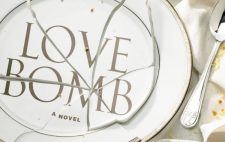Real people doing everyday things are what excite Seward Johnson, the 82-year-old Johnson & Johnson heir and founder of Grounds For Sculpture in Hamilton Township. While Johnson’s whimsical work is seen around the globe, visitors need travel only as far as Hamilton Township where more than 270 sculptures fill 42 acres.
You opened Grounds For Sculpture in 1992. Twenty years later, what makes you most proud?
I am most proud of the impact of the park and the added effect our way of displaying art has on the visitors. Also the intensity of interaction each visitor has with the art and our framing of the art in nature. All of this is so evident every time I go to the grounds. And, of course, it grows every year as the park develops both in the expanding number and variety of artworks as well as the lushness of the nature framing the art. I want to put my arms around the enthusiasm I see pouring out of the visitors there – from every age bracket.
You are well known for your sculptures of regular people doing everyday things. What is intriguing about that work for you?
Humanity is intriguing, the way we each express ourselves, our needs, our desires, our reaction to things we are experiencing. Capturing that so you the viewer feel the figure’s experience, is very exciting to me.
How did you first discover sculpting?
I was painting up in Cambridge, Massachusetts, both in nature and also in class where they had figure studies. I told my wife, Cecelia, that as much joy as painting gave me, I didn’t feel as though I was really working. I needed more resistance. She tore out an ad for a sculpting class so I signed up and went but left halfway through the first class. I was so excited that I got myself a studio, hired a model and did my first sculpture of a nude in stainless steel. It seemed to take me forever, nine months to be exact. The foundry cast it by my directions in stainless steel brought to a high polish. They could not believe that it was my first sculpture and asked me if they could enter it into a competition. I won the competition, the Design in Steel Award by U.S. Steel. There were 11,700 entries. I never won another competition but with that one, I had a life career and, boy is it fun and does it feel great. Each year I’m getting more and more ideas.
You have public placements all over the world. Do people in other countries appreciate your work in different ways?
I think people see themselves or someone they know in my work. Or, I fooled them into asking one of my creations a question, and they immediately look around embarrassed to see who witnessed their faux pas. I guess people all react similarly everywhere.
What inspires your work?
A stroll down the street or through the park or in a restaurant or train, on a campus, wherever there are people being people – being themselves.
What advice do you have for young artists?
At the Johnson Atelier, I tried to help young artists working there to overcome sales resistance. Every artist, every work, is a different marketing problem. Artists must get their work out there to be seen and reacted to. It must move someone to give them something. That is the job of every artist, old and young. Community shows, school shows, park shows and hospital shows all help. We promote all of these. Young artists must be aggressive getting their work out there, so they can give a viewer something to move him or her. That is the magic moment, the power of art.
How do you respond to the criticism of your work?
That’s what makes life fun. There are people who put themselves above others in powers of discrimination but not at my park. It’s your Easter egg hunt, Mr. Viewer, and only you and your gut or visceral response counts to the value of each work you confront. The show of my art at the Corcoran Gallery of Art got about the worst review I’ve ever seen, but nonetheless, it turned out to be the most popular show in the history of the old museum. I’m still smiling.
 What would you like your legacy to be?
What would you like your legacy to be?
I hope my work and also every artist’s work at Grounds For Sculpture positively affects as many people’s lives as deeply as possible.
Why did you choose Hamilton as the place to build GFS?
When the Johnson Atelier kept growing, it moved twice to find larger quarters. Its third and final home was Hamilton – and guess what was right next to it? It was the old New Jersey Fairgrounds or, rather, the rubble-strewn barren land that was left of it. I’ll never forget showing Martin Segal, New York City’s “Mr. Art,” and his wife, Edith, and my wife, Cecelia, that early vista, saying, “I’m going to build a sculpture park here.” You should have seen their faces contorted with false smiles of encouragement and disbelief. It then looked like a site of an old battle.
 What is your favorite piece?
What is your favorite piece?
I’m an artist, that’s an unfair question! I would have to say it’s one of mine called, “If It Were Time,” which is my three-dimensionalization of Monet’s Terrace de Sainte Adresse, where I use the lake as Monet’s English Channel. This piece makes the most of the park’s own natural background while punctuating it with Monet’s iconic shapes to tease your memory and confuse you. I feel as strongly in a different way about Carlos Dorrien’s “The Nine Muses,” a piece that mysteriously reaches back in time, taking you with it. I could go on and on: Bruce Beasley’s piece “Dorion” next door to it, like a giant mechanical bug on a formal pond made to order; Elizabeth Strong Cuevas’ “Arch II Set II” near the gazebo; Philip Grausman’s “Leucantha” in the watery mist across from Rat’s Restaurant; Eva Powel’s spaceship “Oloid” on Sculptor’s Way.


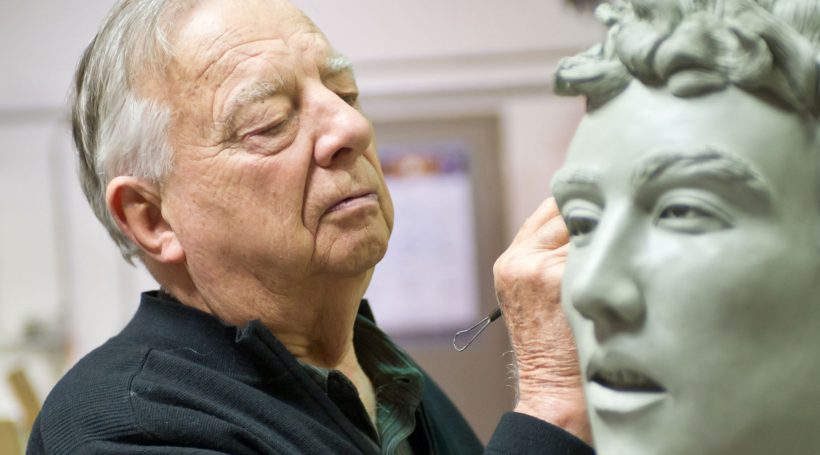
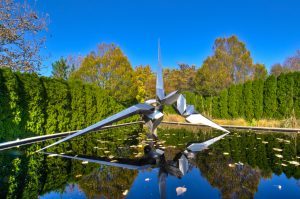
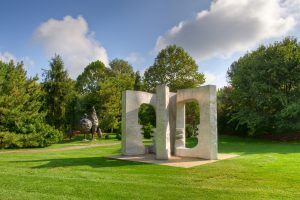 What would you like your legacy to be?
What would you like your legacy to be?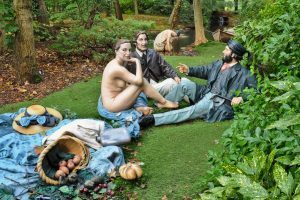 What is your favorite piece?
What is your favorite piece? 